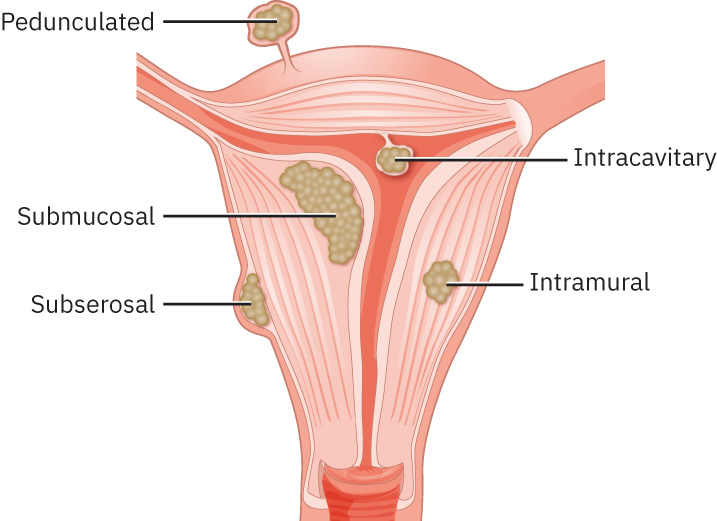18.11 Fibroids
A fibroid, also called a leiomyoma, is a benign, solid tumor that develops from the smooth muscle tissue of the uterus, as illustrated in Figure 18.9.[1] Approximately 50 percent of women with uterine fibroids are asymptomatic, but the remaining 50 percent have symptoms that can significantly affect their quality of life such as heavy menstrual bleeding, pelvic pain, urinary frequency and/or retention, constipation, painful intercourse, and infertility. Endogenous levels of estrogen and progesterone stimulate the growth of fibroids, but hormonal contraceptives do not stimulate their growth and are often used to manage heavy menstrual bleeding. Fibroids are slow-growing and usually regress during menopause because of the corresponding decrease in these hormones.[2]

Fibroids may or may not be palpated on physical examination by a health care provider. They are diagnosed by pelvic ultrasound. Additional diagnostic testing may include hemoglobin, hematocrit, and ferritin for women at risk for anemia due to heavy menstrual bleeding.[3]
Treatment of symptomatic fibroids depends on the client’s desire for future pregnancies. For clients who do not desire fertility, treatment is focused on symptom reduction. Estrogen-progestin contraceptives or progestin-releasing intrauterine devices (IUDs) may be prescribed. If hormonal contraceptives are contraindicated or not desired by the client, tranexamic acid may be prescribed. Tranexamic acid is a nonhormonal oral medication that prevents the breakdown of clots and reduces heavy bleeding. It is contraindicated in clients with increased thromboembolic risk, including those using combined hormonal contraceptive methods and those with a history of thrombosis or hypercoagulopathy.[4]
If initial treatment does not effectively reduce heavy bleeding, gonadotropin-releasing hormone (GnRH) analogs may be prescribed. GnRH analogs shrink the size of fibroids and are often prescribed before surgery. Surgical treatment may include a myomectomy, which is a laparoscopic procedure to remove uterine fibroids while preserving the uterus. It is often recommended for women who wish to maintain fertility. A uterine artery embolization (UAЕ) is a minimally invasive surgical procedure that uses a catheter to block blood flow to fibroids in the uterus, which ultimately shrinks and removes the fibroids. If heavy menstrual bleeding persists, a hysterectomy with ovary conservation may be performed as definitive treatment. A hysterectomy is a surgical procedure that involves removal of the uterus due to various medical conditions such as fibroids, endometriosis, or cancer. After a hysterectomy is performed, there is no menstruation, and pregnancy is no longer possible. Conserving the ovaries prevents symptoms of immediate surgical menopause and associated risks, such as osteoporosis and cardiovascular disease.[5]
For clients who desire future pregnancies, hysteroscopic or laparoscopic myomectomy may be performed to attempt to reduce heavy bleeding while also preserving fertility. Limited research indicates that acupressure may also improve outcomes.[6]
- “d61b3a060e257075c9cfd6e28218814ed0f33ebb” by Rice University/Open Stax is licensed under CC BY 4.0. https://openstax.org/books/maternal-newborn-nursing/pages/4-3-causes-of-infertility#fig-00002 ↵
- Stewart, E. A., & Laughlin-Tommaso, S. K. (2024). Uterine fibroids (leiomyomas): Epidemiology, clinical features, diagnosis, and natural history. UpToDate. https://www.uptodate.com/ ↵
- Stewart, E. A., & Laughlin-Tommaso, S. K. (2024). Uterine fibroids (leiomyomas): Epidemiology, clinical features, diagnosis, and natural history. UpToDate. https://www.uptodate.com/ ↵
- Stewart, E. A. (2024). Uterine fibroids (leiomyomas): Treatment overview. UpToDate. https://www.uptodate.com/ ↵
- Stewart, E. A. (2024). Uterine fibroids (leiomyomas): Treatment overview. UpToDate. https://www.uptodate.com/ ↵
- Stewart, E. A. (2024). Uterine fibroids (leiomyomas): Treatment overview. UpToDate. https://www.uptodate.com ↵
A benign, solid tumor that develops from the smooth muscle tissue of the uterus, also called a leioma.
A surgical procedure to remove uterine fibroids while preserving the uterus. It is often recommended for women who wish to maintain fertility.
A minimally invasive procedure that uses a catheter to block blood flow to the uterus.
A surgical procedure that involves the removal of the uterus. It can be performed for various medical conditions, including fibroids, endometriosis, or cancer. Once performed, menstruation stops, and pregnancy is no longer possible.

